Crack injection and foundation waterproofing. Mississauga and Woodbridge Ont. Can.
Phone:(647) 724-4164
Woodbridge
There are five basic steps to be done when injecting a crack in concrete that is leaking water. This is crack injection 101. Learn these steps and you will be well on your way to understanding what it takes to seal a water leak in concrete. In future articles, we will explore every one of these steps in more detail and address the multitude of options (such as port selection, hole spacing, depth, what to do when you hit rebar, etc.) But for right now, we are going to discuss the most basic steps.
Step 1: Drill holes. Use a hammer drill to drill holes in the concrete that intersect the crack. These holes are usually drilled at a 45 degree angle to intersect the crack halfway through the structure so that the resin is forced towards the front and back of the crack.
Step 2: Flush the holes. When you drill, you create concrete dust. If you don’t flush this dust out of the holes, it will be forced into the crack during injection and may clog the crack preventing resin from getting where it needs to go. Put a flexible hose all the way to the back of the hole so that water flushes the dust from the back of the hole to the surface of the concrete. Flush until clean water is flowing.
Step 3: Install your injection port. The port is what seals the hole and gives the injection pump a direct connection to the crack.
Step 4: Flush the crack. Unless water is pouring out of the crack, you will need to inject clean water through the injection port and into the crack. This serves several purposes:
• Cleans the crack of dirt and other contaminates to allow resin to flow freely.
• Gives you an idea of how far and how easily the resin will flow into the crack when you start injecting the foam.
• Helps to open areas that the resin wouldn’t otherwise flow. Water is
thinner than resin and will penetrate deeper and into tighter areas.
• Ensures the resin will have enough moisture to react with.
Step 5: Inject the resin. Always use the lowest pressure that will continuously feed resin into the crack. Slowly turn up the pressure as necessary to get the resin flowing. My rule of thumb is to keep injecting even if resin starts to flow out of the crack. As long as more resin is going in than is coming out, you are improving your chances of success. When the resin isn’t moving further along the crack, move to the next port.
Foundation crack repair injections, Mississauga, Woodbridge, Toronto, Brampton, Mississauga, East York, north York, Vaughan, Oakville, Burlington, Etobicoke, Ontario Canada.